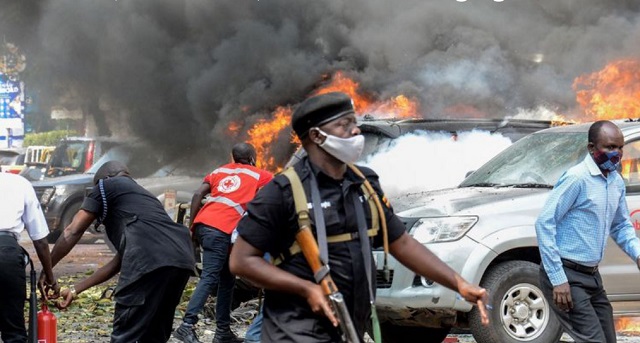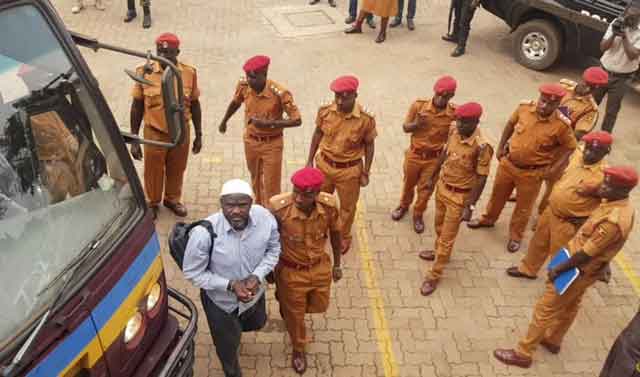
ADF, Islamic State, al-Shabaab working together
COVER STORY | THE INDEPENDENT | The recent terror attacks in Kampala point to a change in tactics by the DR Congo-based Allied Democratic Forces (ADF) and deeper Jihadi coordination with the Islamic State and al-Shabaab of Somalia. They apparently share training and technology and coordinate attacks in the region.
The revelation comes after the global terrorist organisation, Islamic State, on Oct. 07 took responsibility for its first attack in Uganda after detonating explosives inside a police station in Kampala.
But approximately one week earlier, on Oct.01, the Rwandan police had arrested 13 persons linked to ADF alleged to have been plotting a terrorist attack in Kigali.
The plans were assumedly in response to the Rwandan military campaign against the Islamic State in Mozambique. They had explosives and other material to produce bombs.
According to the experts, the ADF use what they call the “Chain Restaurants Model”. They are all trained by the same source and use similar technology but each terrorist cell operates independently.
“If one goes down, it doesn’t affect the others,” the experts say.
The ADF reportedly has logistical links with a group in the United Kingdom and more recently a South African-based criminal network, both of which have provided vital funding. They add that while most of the ADF’s members are from Uganda and DRC, some are from surrounding countries.
The Islamic State’s role appears to be to transfer ideas, tactics, training and personnel. According to the experts, this is how the shift to improvised explosive devices (IEDs) in eastern DRC, Mozambique, and Uganda has come up.
A 2020 UN report on DR Congo described how, from 2019, the ADF started increasingly to use IEDs and that improvement in the technical construction of the explosive ordnances had taken place.
“While impossible to confirm at this stage, this evolution could be the result of technical assistance from other IS affiliates,” the UN report said.
The likelihood of such collaboration in terms of the IED production is further strengthened by the finding on June 72019 of an IED in Beni with a paper attached with the text “Made in Dawlah”, potentially a reference to IS (usually referred to as “Dawlah” by its supporters) and a tactic that has been used by supporters in other regions.
The UN says such an interpretation is supported by a recent UN report stating that there has potentially been coordination and transfer of know-how, resulting in an increasing coherence in modus operandi.
On Sept. 21, the DR Congo army had arrested a Jordanian working with ADF. According to news reports, the Jordanian was in charge of the ADF’s drone program.
Those incidents, according to a report by the International Centre for the Study of Radicalisation of the Department of War studies at King’s College London, appear to be clear signs of collaborated movement by terrorists in the region.
Attacks by ADF in Kampala have until now been done mainly by assassinations done by men riding on motor-bikes hitting high-profile targets. But their tactics appear to be changing.
On June 01 alleged ADF assassins attacked a vehicle carrying Uganda’s Transport Minister and former army commander, Gen Katumba Wamala, killing his daughter and driver.
But on Oct. 07, 2021, Islamic State announced that its fighters had detonated an IED at a police post in Kawempe, a suburb of Kampala City. But the police denied such an attack happened. In any case, there appears to have been no damage or casualties at the police post.
But the eruption of a new wave of terror attacks was cemented when an explosion hit an eatery in Komamboga in the same outskirt of Kampala city on Oct.23 killing a 20-year-old waitress and injuring three others. And Islamic State quickly claimed responsibility that too. Still Police dismissed the IS-link.

Police’s spin-master, spokesman Fred Enanga said the bombings were the work of domestic terrorist cells of the ADF.
Two days later, however, a suicide bomber detonated an explosive on a long-distance bus 30km west of the capital, killing himself and Islamic State claimed that too.
And when on Nov.16, suicide bombers exploded two devices almost simultaneously; one near the main police station in Kampala city and the other near parliament, killing at least seven people and injuring more than 37, even the police spin-masters appeared to run out of words.
“We believe there are still more members of these domestic terror cells, especially the suicide bomb squad that has been created by the ADF,” Enanga told journalists.
The emergency of new tactics of suicide bombings as opposed to ADF’s familiar assassinations is significant.
Unlike assassinations which aim to paralyse the political leadership of a country and cause all of them to live in fear, guarded by equally scared convoys of security operatives, bombings spread terror among the general population, sowing chaos and division in society and hemorrhaging the economy even more through increased security and military expenditure to fight and defend against attacks.
Assassinations sow chaos through the killing of leaders, but suicide bombings sow chaos through the ripple effect of the attack. Everyone in the country starts wondering where the next attack will be. Security check points intensify, multitudes of suspects are rounded up and locked up without trial, many suspects are killed without due process, anger against the government grows, and eventually – if the terrorists are not defeated – the system collapses under its own weight. That is possibly what the ADF, Islamic State, al-Shabaan, who are working together against President Yoweri Museveni’s government, could be hoping for.
The post Terrorists gang up against Museveni appeared first on The Independent Uganda:.
from The Independent Uganda: https://ift.tt/3kVS578
0 Comments